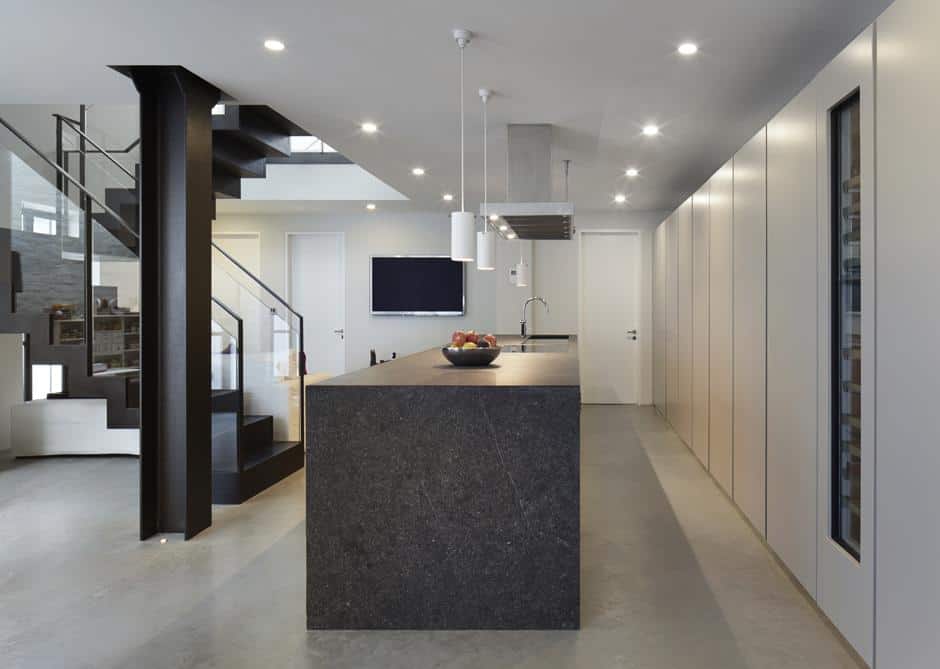BLOG
INTERESTING STUFF
THAT CAUGHT OUR EYE
Why You’re Wrong About Warmth in Modern Homes

Last week, I talked about the challenges of making a period home stay warm. Now, I want to talk about a very different heat-related problem: making people believe that contemporary styled builds aren’t cold.
Even though increasingly strict regulations demand that any new build achieves a high standard of thermal efficiency, people still accuse contemporary builds of looking cold. But what they’re referring to isn’t the physical warmth of the house but their perception of its warmth, which is far more complicated than anything you can measure with a thermometer.
Let’s start with some light science.
When you touch a material, the sensation of how hot or cold it is isn’t determined by its temperature but by its thermal conductivity, which is how fast heat transfer occurs. Heat flows from a warm medium to cold, so if you touch a highly conductive metal that’s a lower temperature than your hand, it literally drains the warmth from your skin, making it feel colder than a material of the exact same temperature that has lower conductivity.
That’s why when you touch a metal pan you’ve left in your fridge it feels so much colder than the air around it. Air transmits heat to and from your hand very slowly, while metal transfers very quickly.
Thermal conductivity is essential to house building. Most people in the UK will have grown up or currently live in houses that feature central heating systems with radiators. These radiators heat the air, causing it to travel up to the ceiling where it eventually cools and cycles back around to the radiator to be heated again.
The problem with radiators is that they heat the air without directly heating any surfaces. You’ve probably stepped on a cold bathroom floor barefoot and know how unpleasant that can be, even if the air temperature is comfortable. This cold floor issue is why so many houses feature carpets which conduct heat far slower than bare concrete, tiles or wood.
This association between bare floor materials and coldness can be very hard to break for people in the UK, yet someone from Sweden would see a polished concrete floor and assume they can comfortably lie across it. Why? Because of underfloor heating.
Underfloor heating is seen by many as a modern invention but it’s actually a far older technology than radiators, dating back to at least Roman times (as I saw first hand when I visited the ruins in Vaison) and it’s been the traditional source of heating in Scandinavian countries and much of Europe since the 80s.
By heating the floor directly, air temperature increases along with the floor temperature, making the experience of being in an underfloor heated room far warmer than one with radiators, even if their ambient temperature is identical. This is due to the sensation of heat transfer from floor to foot.
Even with underfloor heating, you’ll still find more people choose a wooden floor over polished concrete despite concrete having around twice the thermal conductivity. The association between concrete and cold industrial buildings is still too strong for most, though its use is increasing in modern home building, including many of our own projects, such as Emperor’s Gate, pictured above.
We’re even starting to see experimental interior designers use metal in their flooring. I must say that even I struggle with the idea of walking across a metal floor, despite knowing it’s far more conductive than concrete!
Achieving perceived warmth has more tricks to it than I can list here. I’ve only really talked about materials, but lighting is equally important, as we associate darkness, especially exterior darkness, to cold. By flanking the exterior with lights – as you can see here in White Lodge – we create the illusion that the interior extends beyond the glass, pushing the cold and darkness further away.
And then, of course, there’s colour, where subjectivity reaches its peak. Everyone has their own ideas for what hues make a room feel warm or cool, which is why it’s so important for us to have our interior designers, Karen and Jemima, in-house. They work closely with the architectural team and the client to achieve the perfect balance between light, space, comfort and warmth.
So the next time you declare that a house looks cold, ask yourself why you reached that conclusion. Indeed, it’s fascinating to meet people from countries where new builds are the default and perceptions are reversed: old means cold, new means warm.
John Dyer-Grimes
